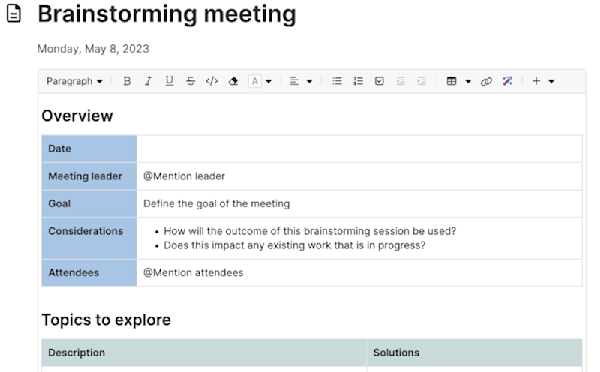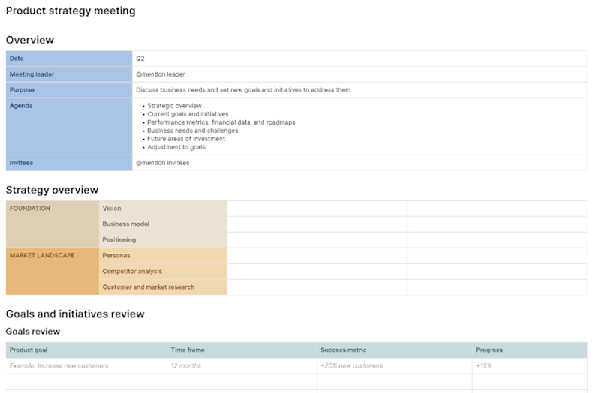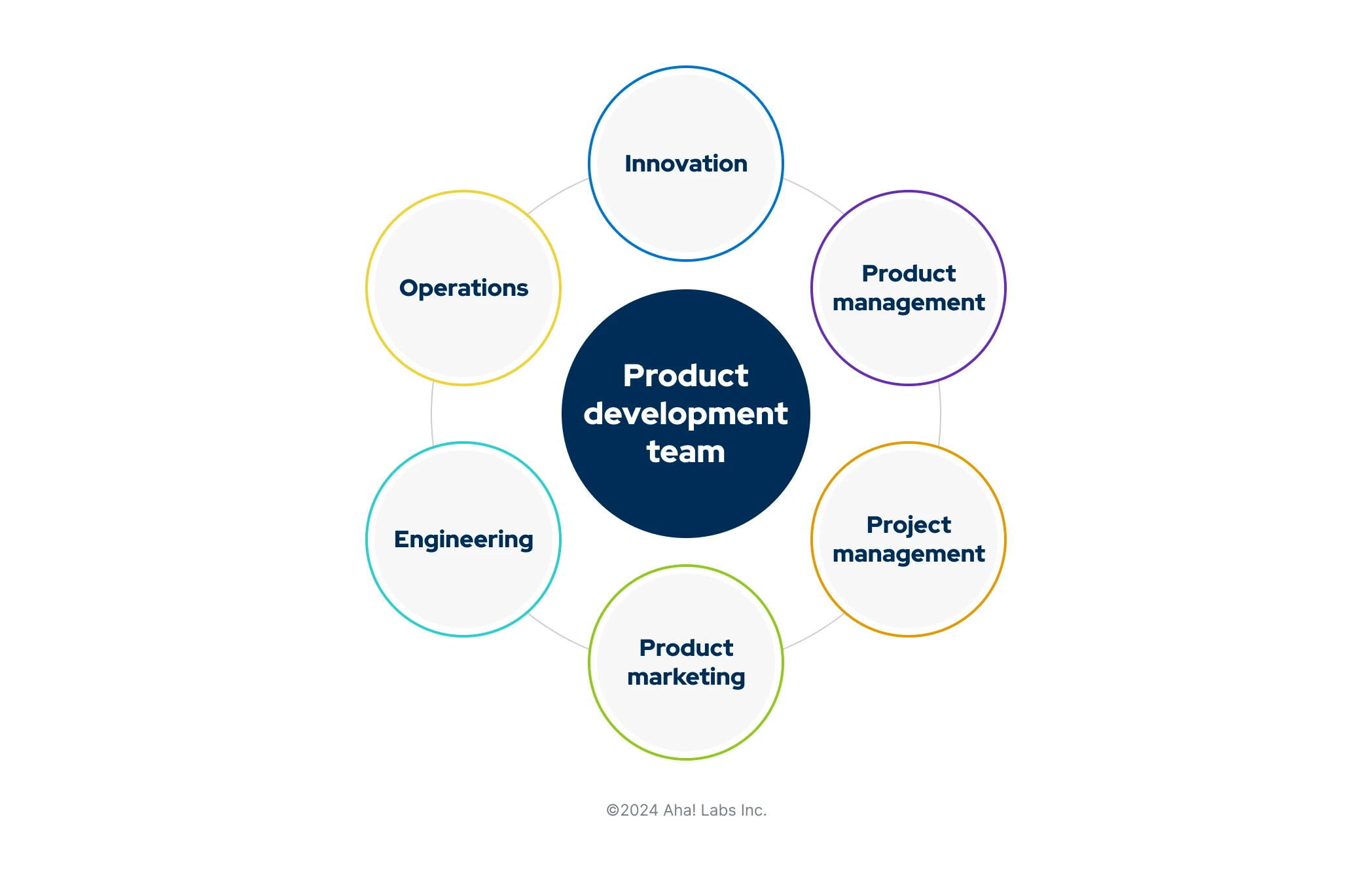The broader product team often includes representatives from marketing, sales, and customer support. These individuals provide necessary cross-functional context that informs the core product development team's decision-making. Although the work of these other teams supports overall product success, these folks are not as close to the day-to-day details of planning, building, and managing a product.
Related:
Different roles in a product development team
A product development team reflects the product being built and the organization that offers it. Say you have a very complex product from an enterprise company — you might spin off product development teams around different areas of functionality or technology. But at a startup with a nascent offering, it is much more common to have a team that focuses on every aspect of the product.
Here are a few of the professional roles you might find on a product development team, presented in alphabetical order and excluding senior or executive-level titles:
Related:
Top
Traits of a good product development team
All high-performing teams share a few similar traits. This is true regardless of what goal the group is working toward — whether it is moving a soccer ball across a pitch or transforming a concept into a digital experience that delights users. Teamwork runs on a mindset that the whole is greater than the sum of its parts.
Because product development is so dynamic, you could create a large list of traits that would benefit the people behind the process. However, there are five basic attributes that you will typically see on a smoothly functioning product development team:
Transparent: Open communication is essential. The best product development teams express ideas and share feedback with clarity. There are no hidden agendas.
Curious: Striving to understand the "why" behind any issue is a hallmark of effective product development teams. These folks are always asking questions to understand the true meaning.
Empathetic: Customer centricity drives product success. Product development teammates cultivate a sense of empathy for users and one another that leads to better solutions — and brings meaning to the work.
Creative: Delivering real value requires out-of-the-box thinking. Exceptional product development teams are nimble freethinkers who can approach a problem from different angles.
Pragmatic: Product development has real costs. That means product development teams always search for the most practical solution that will deliver the most value in the least time with minimal effort.
Related:
Top
Should a product development team report to engineering or product management?
This is one of the most hotly debated questions among product builders. The answer depends on a few factors, including company maturity, size, and industry. For example, you often find engineering-led product development teams at early-stage startups. These folks are resourceful and determined. Instead of following an established product development framework (like you often find at more mature organizations), these teams are frequently in rapid-build mode. There is little to no formal structure and no dedicated groups for product management, software engineers, product designers, and so forth.
Some companies have a founder who is the technical brain behind the product. In addition to acting as CEO, this person might assume the role of CPO and CTO — a dual responsibility that can challenge diversity of ideas. Product managers and engineers each bring unique skills to the product development process. If company leaders like this approach product decisions only from a developer-first mentality, they can miss out on valuable perspectives and expertise.
Product development teams are not one-size-fits-all. Functional groups will each have their own team structure and play a complementary role in supporting the process of taking an idea from concept to go-to-market launch. Product managers and engineers who work together on the same product in a formal way will report to managers within their functional department.
The delineation is always a bit fuzzy with this type of cross-functional work. There are often so-called "dotted-line" management relationships between senior leaders and colleagues within a product development team. This term refers to someone who might assign you a task or review your work, but is not ultimately in a position to discipline or reward you in a conventional management way. Clear communication between individual teammates, direct managers, and dotted-line managers is essential to avoid competing priorities or contradictory directives that can delay progress and frustrate everyone involved.
Related:
Top
Tips for choosing a strategic approach to product development work
Product development work encompasses everything from strategizing and brainstorming to planning, building, and bringing a product to market. It also entails continuously measuring success and seeking ideas and feedback on how to deliver even more value. This complexity is why many teams adopt a proven product development methodology to manage the process.
You have probably heard of the most common approaches already. But many teams find it difficult to adhere to a rigid, prescribed way of working. This is why some of them follow a blend of two or more popular methodologies, picking and choosing the elements that make sense for their product and organization.
Our team follows The Aha! Framework for product development. It is a flexible way to take a strategic approach to agile work — without the excessive ceremonies, nomenclature, and rules present in more traditional agile methodologies. This makes our framework easier to adopt and scalable for product teams of all sizes and maturities.
So how should you determine whether to adopt The Aha! Framework, the Scaled Agile Framework®, kanban, or a different methodology altogether? Here are some tips on evaluating which might be the best fit:
Assess team and project requirements: Evaluate your team's level of experience and take things such as organizational culture and the scope of your typical projects into account. Does more flexibility or more structure suit you better?
Evaluate constraints and resources: Consider factors such as the size of your team, everyone's skill sets, and the tools you use today (or plan to implement). Would your projects, team, and tools logically fit with the methodology or framework you are evaluating?
Run an experiment: If possible, try piloting a framework or methodology with a small, low-stakes, or internal project. How did it go?
Gather feedback: Ask for input from product and engineering teams as well as stakeholders and folks from cross-functional groups — everyone who plays a role in the entire product development process. How do they think the pilot went, and what needs improving?
Document your learnings: Review the feedback and results of your experiment. Brainstorm about where you might need to adapt or blend activities or parts of the process, and be open to starting this process again with a different framework if necessary.
Ultimately, all methodologies and frameworks have the same purpose: to help people work together efficiently and deliver the most value. No matter which framework you choose, make sure everyone agrees on and commits to your approach. This will help the team focus on solving customer problems instead of getting distracted by the "how" behind the work.
Related:
Top
3 best practices for leading a product development team
Product development teams grow over time. As the company scales, so does the group supporting the product (or products) that it offers. Formalizing team structures and hiring new folks should be approached prudently. Throwing more people at a problem is not always the way to solve it — this often creates more discord and confusion as people adapt.
Instead, be circumspect. A good way to do this? Catalog current organizational charts, job descriptions, and overall duties. You can then reference your company vision and product strategy to create a team charter. This is a living document that outlines responsibilities, communication guidelines, product development frameworks or methodologies you follow, and team expectations. As you hire new folks, the team charter becomes a valuable training tool. And it can be a touchstone for managers as teammates thrive (or stumble).
With all of this in mind, here are some best practices for building and managing your product development team.
Hiring best practices
Product development teams span a variety of disciplines. Ensuring that prospective hires have the required technical skills and practical experience is obvious, but there are a few other things to look for in candidates.
Streamline your hiring practices to build an outstanding product development team:
Define the position to be filled with a focus on competencies.
Create a skills inventory with hard and soft skills to hire for.
Seek candidates that exhibit the five traits we listed earlier: transparency, curiosity, empathy, creativity, and pragmatism (these are just as critical as technical acumen).
Be open to nontraditional work histories and experience.
Develop a standard assessment method (like a test or project).
Practice behavioral interviewing that elicits context-specific answers.
Ensure candidates speak with a variety of employees.
Management best practices
There is no designated manager of a product development team. You have de facto leaders (typically the product manager). But there should be a sense of a "flat" structure to the group — this helps people feel confident and comfortable sharing ideas, feedback, criticism, and praise.
Leverage these management tactics to support a productive and high-functioning product development team:
Collaboration best practices
Individuals have a responsibility to honor the team charter, work together toward achieving the product vision, and help reach set goals and KPIs. (Remember: The whole is greater than the sum of its parts.) But product managers do hold a unique position of leading the product development team without express authority.
Follow these recommendations to foster fruitful collaboration:
Establish a "one team" mentality.
Communicate effectively.
Share the product vision.
Represent business and customer needs.
Provide access to roadmap plans.
Optimize meeting time.
Avoid micromanaging.
Display an entrepreneurial spirit.
Eliminate drama.
Throw credit to others.
Inject a sense of play.
Product development is exhilarating. You have a rare opportunity to bring ideas to life. You have the responsibility to deliver on business goals. And you have the privilege to solve real problems for real people. This is serious work — but it should be enjoyable. Try to have fun and celebrate with the folks who join you on your product development journey.



